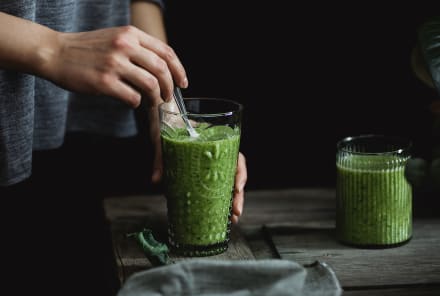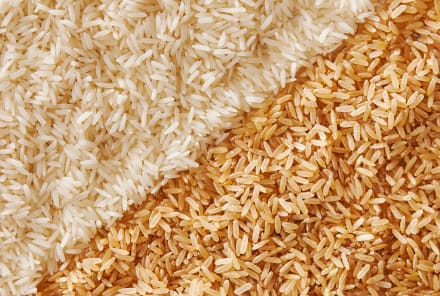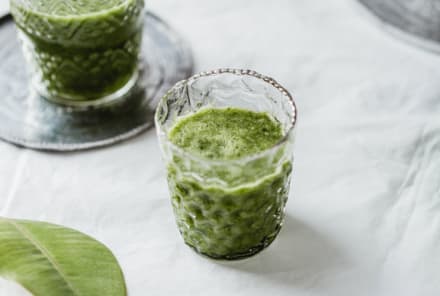Advertisement
Are You Getting The Vitamins & Minerals You Need? How To Tell (And What To Do About It)

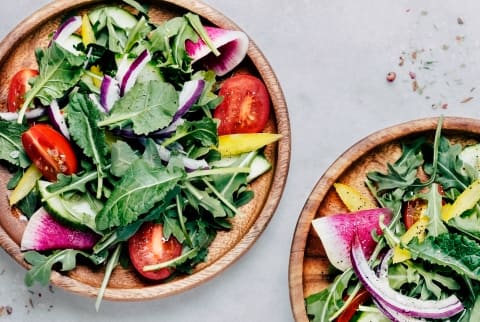
You may have heard this term before, but to clear things up, micronutrients are vitamins and minerals. We only need micronutrients in tiny amounts (hence "micro"), but they are essential to help our bodies function properly, prevent disease, and for overall well-being. Most vitamins and minerals are either not produced by our bodies, or they are produced in very small amounts, which means we need to find them in food or from the environment (like vitamin D from the sun). There are 14 different vitamins and 16 different minerals that our bodies need, and they each carry out an important and diverse function in the body.
You might have also heard about water-soluble or fat-soluble vitamins. Water-soluble vitamins are not stored in the body and are generally nontoxic if you consume too much of any of them. Any excess amount that we consume from food or supplements leaves our bodies through our urine. Fat-soluble vitamins (vitamins A, D, E, and K) require fat to be absorbed from the diet and can also be stored in the body's fat tissue. Some fat-soluble vitamins have the potential to be toxic1 if consumed in large quantities (particularly if you are taking supplements). On the other hand, for both vitamins and minerals, if we consume too little, there can be undesirable or even devastating consequences.
How do micronutrients differ from macronutrients?
Macronutrients are what we are all familiar with and hear so much about—carbohydrates, proteins, and fats. The main difference between micronutrients and macronutrients is that we need more macronutrients in our diet; however, that doesn't mean micronutrients are any less important. In fact, without the trace amounts of these micronutrients in our diets, serious deficiency problems can arise. Take iron, for example. Although iron is relatively easy to obtain from the diet, infants, young children, teenage girls, pregnant women, and postmenopausal women are more at risk for not getting enough (in addition to those with gastrointestinal disorders or strict or limited diets, including vegans and vegetarians). A deficiency in iron2 can lead to anemia, poor immune function, difficulty exercising (due to low oxygen levels in the blood), problems with body temperature regulation, etc. Those are all in addition to feeling tired all the time, weakness, dizziness or lightheadedness, and even poor appetite, among other things. In short, just like macronutrients, micronutrients are an essential part of a healthy diet and life.
What are the types of micronutrients, and where do you get them?
So which micronutrients do we need exactly? Let's go through each of them, and I'll explain everything you need to know from your daily needs to the function in your body and where to find them. Some vitamins and minerals are found in a vast variety of foods and beverages, so use this list to get an idea of where you can find specific nutrients.
Vitamins
Biotin: The adequate intake3 (AI) for biotin (vitamin B7) is 30 mcg. Its function is to extract energy from fats, proteins, and carbohydrates; aid in cellular growth and repair, DNA repair, gene expression; and hair, skin, nail, and digestive health. Sources of biotin are found in organ meats, yeast, milk, eggs, fish, seeds, nuts, sweet potato, spinach, broccoli, oatmeal, and bananas.
Choline: Choline is water-soluble and vitamin-like. It has an AI of 425 mg for women and 550 mg for men. It is important for brain and nervous system function, metabolism regulation, liver health, and reduced risk of breast cancer. Sources4 include milk, eggs, liver, peanuts, tofu, fish, kidney beans, wheat germ, broccoli, quinoa, spinach, potatoes, chicken, navy beans, and soybeans.
Folate: Folate5 is naturally present in foods, while folic acid is the synthetic form found in enriched grains and cold cereals. Folate/folic acid are necessary for DNA synthesis and repair, cell division, neural tube formation and may protect against initiation of cancer. Natural sources of folate are found in dark leafy greens, vegetables, citrus fruits, legumes, nuts and seeds, dairy products, and grains. The recommended daily allowance (RDA) is 400 mcg.
Niacin6: Also, known as vitamin B3, niacin has an RDA of 14 mg for women and 16 mg for men. Its function is to aid in healthy skin, nails, mobility, DNA metabolism, cell communication, and cognitive functioning. It is found naturally in yeast, meat, fish, milk, eggs, green vegetables, and cereal grains.
Pantothenic acid: This vitamin, which is also known as vitamin B5, has an AI of 5 mg. It aids in cellular function, fatty acid synthesis and metabolism7, and hormone and cholesterol production. It is found in fortified cereal, beef liver, shiitake mushrooms, sunflower seeds, chicken, tuna, milk, potatoes, and eggs.
Riboflavin: Also, known as vitamin B28, this vitamin has an RDA of 1.1 mg for women and 1.3 mg for men. It helps convert macronutrients into energy; it aids in growth and development; healthy hair, skin, and nails; blood cell formation; and strengthens immunity by producing antibodies. It's found in many healthy sources, including eggs, organ meats, lean meats, milk, fortified cereals, and leafy vegetables.
Thiamin9: Vitamin B1 (the other name for thiamin) has an RDA of 1.1 mg in women and 1.2 mg in men. It aids in converting carbohydrates into energy10, promotes healthy hair, skin, heart, and nervous system. It also supports efficient digestion and proper muscle development. Sources of thiamin include whole grains, meat, fish and black beans, and fortified cereals.
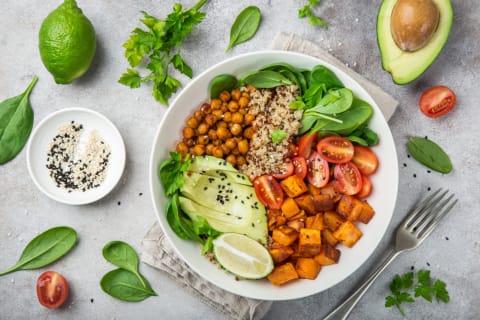
Pyridoxine: Pyridoxine, also known as vitamin B6, has an RDA of 1.3 mg. It helps in turning macronutrients into energy. It also helps form new red blood cells and develop neurotransmitters, helps build the immune system and balance hormone changes. Sources include fortified cereals, chickpeas, fish, beef liver, potatoes (and other starchy vegetables), and fruit.
Vitamin B1211: This vitamin has an RDA of 2.4 mcg12. It promotes healthy nerves, red blood cell/DNA formation and, like other B vitamins, assists in converting carbohydrate, fat, and protein into energy. It can be found mainly in animal products such as meat, fish, poultry, eggs, milk products, and fortified cereals.
Vitamin C13: This important vitamin has an RDA of 75 mg in women and 90 mg in men. It aids in collagen production14; acts as an antioxidant14; and promotes wound healing, bone and tooth development, and blood vessel health. It also helps protect skin from sun damage. It is naturally found in citrus fruits as well as red/green bell peppers, broccoli, strawberries, tomatoes (also tomato juice), cantaloupe, cabbage, cauliflower, and potatoes.
Vitamin A: This vitamin is found naturally in animal sources as retinol. In plant sources, it is known as beta-carotene. Vitamin A is well-known as contributing to vision health but also aids in immune health; tissue, skin, and bone development; as well as reproduction. Like other fat-soluble vitamins, it can be toxic in high doses. It can be found in liver, fish oils, egg yolk, sweet potato, spinach, carrots, winter squash, cantaloupe, and enriched dairy products. The RDA for vitamin A is 2,333 IU in women and 3,000 IU in men.
Vitamin D15: This sunshine vitamin has an RDA of 600 IU and is involved in maintaining healthy bones and teeth. It is necessary for calcium and phosphorus maintenance, brain health, mood support, the nervous system, muscle strength, and reducing inflammation. It can be found in fatty fish such as salmon (with the skin), tuna, mackerel, fish oils, beef liver, cheese, egg yolks, and fortified milk and breakfast cereals.
Vitamin E: This vitamin is also known as alpha-tocopherol, and it has an RDA of 15 mg. It acts as an antioxidant16, helps in muscle growth, reduces risk of cataracts, and promotes healthy neurological function and immune health. It can be found in food items such as wheat germ oil, nuts and seeds, vegetable oils, leafy greens, and fortified cereals.
Minerals
Calcium: This is the most abundant mineral17 in the body with an RDA of 1,000 mg17. It helps provide strong bones and teeth, a healthy heart; supports muscle function; and helps maintain proper hormone secretion and nerve transmission. Its sources include milk, yogurt, cheese, sardines, fortified milks, tofu, orange juice, fortified cereals, kale, and broccoli.
Chloride: This mineral has an AI of 2.3 g and aids in cellular health and maintaining acid and base balance in the body. Sources of chloride include table salt, sea salt, seaweed, rye, tomatoes, lettuce, celery, olives, and many vegetables.
Chromium18: The mineral chromium has an AI of 35 mcg and is involved in fat and carbohydrate metabolism/storage. It aids in proper brain function and also enhances insulin sensitivity. It can be found in broccoli, grape juice, whole grain products, beef, turkey breast, potatoes, and garlic.
Copper: This mineral has an RDA19 of 900 mcg. It plays a major role20 in bone, tissue, brain, and heart health. It helps strengthen the immune system and form red blood cells, as well as improves iron absorption. It can be found in oysters, shellfish, whole grains, beans, nuts, potatoes, organ meats, leafy greens, and dried fruits.
Iodine: The mineral iodine has an RDA21 of 150 mcg and has a key function in cellular metabolism as well as maintaining thyroid function. It also assists other micronutrients in growth and development. It can be found22 in seaweed, seafood, dairy, iodized salt, bread, and other grains.
Iron23: This well-known mineral has an RDA of 8 mg. It is important in red blood cell and energy production, metabolism, and growth/development. It is found in lean meats, seafood, nuts, white beans, dark chocolate, lentils, spinach, tofu, and fortified grains.

Magnesium: This macromineral is involved in over 300 reactions in the body. It has an RDA of 310 to 420 mg and plays a role in energy production; muscle, heart, and nerve function; blood glucose control; blood pressure regulation24; and aids in digestion. It's also often used to help with relaxation or sleep. Food sources of magnesium include green leafy vegetables, legumes, nuts, seeds, and whole grains.
Manganese: This mineral is found mostly in grains, vegetables, and tea. It plays a role in metabolism, bone and tissue development25, and free radical protection. It has an AI of 2.3 mg.
Molybdenum: You may not have ever heard of this micromineral. We only require 45 mcg, but it plays a role in enzyme and cellular function. It is found mainly in legumes, grain products, and nuts.
Phosphorus: This mineral is involved in bone and tooth development, metabolism, cell and tissue repair and energy production. The RDA is 700 mg, and it is found in most food sources, such as beans, nuts, milk, meat, and even processed foods and soft drinks (although this is not necessarily a good reason to overconsume these last two items!)
Potassium26: This important mineral has an AI of 4.7 g. It plays a major role in overall health of cells27, maintaining blood pressure; electrical conduction in the body; muscle, heart, brain/nerve functioning, and digestion. Its main sources include apricots, legumes, prunes, squash, raisins, potatoes, orange juice, banana, milk, spinach, meats, poultry, and fish.
Selenium: This mineral has an RDA of 55 mcg. It has antioxidative properties, as well as maintains thyroid health, DNA synthesis, bone health, and reproduction. Good sources include Brazil nuts, seafood, organ meats, poultry, cottage cheese, brown rice, eggs, and fortified cereals.
Sodium3: This important mineral has an AI of 1.5 g. It helps balance body fluids and participates in proper nerve and muscle functioning, as well as helps to regulate blood pressure. Sodium also plays a role in helping glucose transport into cells28. Good sources include meat, fish, dairy, bread, processed foods, and table salt.
Sulfur: This mineral does not have an RDA, AI, or an estimated average requirement (EAR) due to its requirements being met when sulfur-containing amino acids29 (proteins) are consumed. Functionally, it is important because it plays a role in cellular and tissue health, enzyme function and protein synthesis. Sources include dairy products, eggs, beef, poultry, seafood, onions, garlic, turnips, kale, and broccoli.
Zinc: With an RDA of 8 mg in women and 11 mg in men, this mineral aids in immune system support, production of proteins and DNA, wound healing30, and functions in the taste and smell systems. Its main sources31 are oysters, red meat, poultry, crab, lobster, beans, dairy, cashews, chickpeas, and fortified cereals.
Do you need to supplement with micronutrients?
Do I need a supplement? This is a common question plagued by most people today, whether or not you're already taking one (or two). The short answer is: maybe. The first thing to consider is that a dietary supplement is just that, a supplement. So by taking a supplement, you are adding to your diet something that is either missing or that you want more of in the form of a pill, tablet, liquid, spray, etc.
Often a person might need a specific nutrient when the diet is lacking or gastrointestinal problems affect a nutrient's absorption. Other times, like during pregnancy, supplementation is necessary to help support the changes in our body and new life we are growing. But what about just a general daily multivitamin?
In 2011, the total sale of nutritional supplements was $28 billion, and $11 billion of this was for multivitamins alone. There's no doubt that they are popular. So, let's take a look at why you might benefit from taking a multivitamin supplement on a daily basis.
Instead of looking at the general population as a whole, it's more important to think about our own diets and what we might need. For example, if you're a busy person or your eating patterns are erratic, and your diet is mostly fast food or convenience items, you're likely going to benefit from a multivitamin. If you have to follow a strict diet due to a health condition and find yourself eliminating many foods from your diet, you may also benefit from a multivitamin.
It is also important to remember that the amount of each micronutrient that you need can vary if you are a man vs. a woman, as well as throughout the lifespan. For example, if a woman becomes pregnant, she needs more of some micronutrients (like folate), and the amount that is optimal for health can even vary from trimester to trimester. Also keep in mind that while the values described above are for adults, kids32 have different nutritional needs. Plus, when you get older, you may need more of some micronutrients in order to feel your best. For example, older women often need more calcium in their diets to help reduce the risk of developing osteoporosis or other bone-related problems. That's why if you are going to take a supplement, it is best to use a brand that has formulations that change over the life span, like Rainbow Light's Vibrance line.
There are so many vitamins and minerals to think about, it can be overwhelming. How do you make sure you are getting all of the 14 vitamins and 16 minerals that you need (and in the right amounts) on a daily basis? The good news is, as long as you eat a whole-foods-based and varied diet, it is more than likely that you will get all the nutrients you need. We might not get the right amount of each nutrient on a daily basis, but our diets may balance out over a few days or a week. If you're concerned that you may not be getting what you need, there's not likely to be any harm in reaching for a multivitamin. Just make sure not to take more than the recommended dosage, you don't want to overdo it!
32 Sources
- https://www.ncbi.nlm.nih.gov/books/NBK234920/
- https://www.ncbi.nlm.nih.gov/pubmed/26344176
- https://ods.od.nih.gov/Health_Information/Dietary_Reference_Intakes.aspx
- https://ods.od.nih.gov/factsheets/Choline-HealthProfessional/
- https://ods.od.nih.gov/factsheets/Folate-Consumer/
- https://lpi.oregonstate.edu/mic/vitamins/niacin
- https://lpi.oregonstate.edu/mic/vitamins/pantothenic-acid
- https://ods.od.nih.gov/factsheets/Riboflavin-HealthProfessional/
- https://ods.od.nih.gov/factsheets/Thiamin-HealthProfessional/
- https://www.ncbi.nlm.nih.gov/pmc/articles/PMC1375232/
- https://ods.od.nih.gov/factsheets/VitaminB12-HealthProfessional/#h3
- https://ods.od.nih.gov/factsheets/VitaminB12-HealthProfessional/
- https://ods.od.nih.gov/factsheets/VitaminC-HealthProfessional/
- https://lpi.oregonstate.edu/mic/health-disease/skin-health/vitamin-C
- https://ods.od.nih.gov/factsheets/VitaminD-HealthProfessional/
- https://ods.od.nih.gov/factsheets/VitaminE-HealthProfessional/
- https://ods.od.nih.gov/factsheets/Calcium-HealthProfessional/
- https://ods.od.nih.gov/factsheets/Chromium-HealthProfessional/
- https://www.ncbi.nlm.nih.gov/books/NBK222312/
- https://lpi.oregonstate.edu/mic/minerals/copper
- https://ods.od.nih.gov/factsheets/Iodine-HealthProfessional/
- https://ods.od.nih.gov/factsheets/Iodine-HealthProfessional/#h3
- https://ods.od.nih.gov/factsheets/Iron-HealthProfessional/
- https://ods.od.nih.gov/factsheets/Magnesium-HealthProfessional/
- https://lpi.oregonstate.edu/mic/minerals/manganese
- https://lpi.oregonstate.edu/mic/minerals/potassium
- https://lpi.oregonstate.edu/mic/minerals/potassium#membrane-potential-maintenance
- https://www.ncbi.nlm.nih.gov/pmc/articles/PMC4019254/
- https://academic.oup.com/jn/article/136/6/1636S/4664439
- https://www.ncbi.nlm.nih.gov/pmc/articles/PMC5793244/
- https://ods.od.nih.gov/factsheets/Zinc-HealthProfessional/
- https://lpi.oregonstate.edu/mic/life-stages/children
Watch Next
Enjoy some of our favorite clips from classes
Enjoy some of our favorite clips from classes
What Is Meditation?
Mindfulness/Spirituality | Light Watkins
Box Breathing
Mindfulness/Spirituality | Gwen Dittmar
What Breathwork Can Address
Mindfulness/Spirituality | Gwen Dittmar
The 8 Limbs of Yoga - What is Asana?
Yoga | Caley Alyssa
Two Standing Postures to Open Up Tight Hips
Yoga | Caley Alyssa
How Plants Can Optimize Athletic Performance
Nutrition | Rich Roll
What to Eat Before a Workout
Nutrition | Rich Roll
How Ayurveda Helps Us Navigate Modern Life
Nutrition | Sahara Rose
Messages About Love & Relationships
Love & Relationships | Esther Perel
Love Languages
Love & Relationships | Esther Perel

